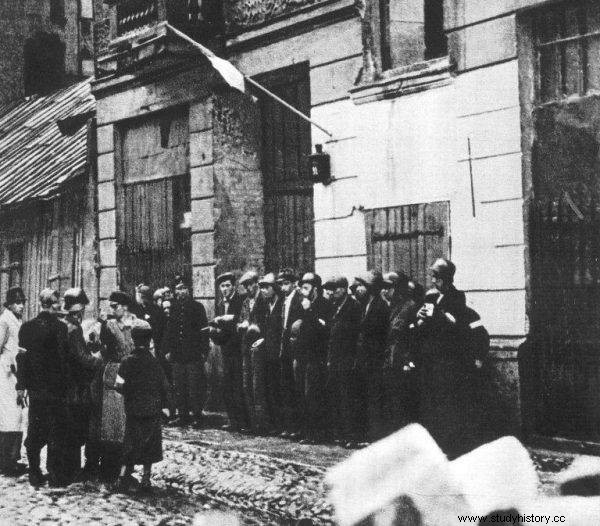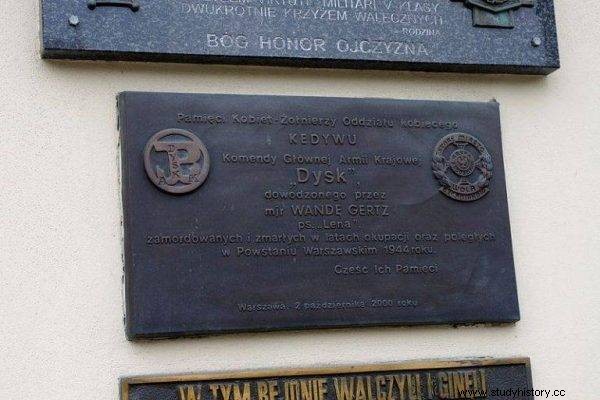Brave, steadfast and uncompromising. Wanda Gertz, the pseudonym "Lena", was not disturbed even by the fact that in her time no women were called to the army. You need to know her story!
The Second World War found her forty-three with a significant history of service to the glory of her homeland. She put passion and great commitment into everything she did. An analysis of her activities suggests that she has found a way to extend the day !
She performed her first action for Kedyw perfectly. It consisted in the liquidation of the informant. The description of the execution is quoted by Agnieszka Lewandowska-Kąkol in her latest book "Where the devil could not ... Kedywianki in action":
"Lena" touched the revolver in her pocket. She stroked it lightly, as if unable to check anything in this situation, she wanted to ensure its reliability in this way. In one graceful movement she jumped onto a path trodden in the grain, probably due to people shortening their way from the stop, and faced the approaching informant.
When this one was very close, with a slightly trembling voice she began to pronounce the sentence of the Home Army sentence:"On behalf of the Polish Underground, you are sentenced to death for ...". She broke off just as the terrified woman began to look through her eyes for an escape route. She fired. The shot was accurate. Now “Lena” walked slowly around the body and along the same path that the dead man had just followed, she went towards the bus stop. She got on a tram that was just starting to move.
The management of the Warsaw District of the Home Army Headquarters also sent a man to secure this action. He was to observe and step in in case of complications. This assistance turned out to be completely unnecessary. "Lena" was uncompromising, precise and consistent in her blood.
You won't take me to tears
Wanda Gertz seemed dry and essential to her subordinates, but at the same time extremely caring. She did not put anyone in danger, and if she could, she undertook tasks that could cause traumatic experiences in others.

The photo shows the collection of insurgents in Wola during the "W" hour.
She made difficult decisions, which often influenced the perception of her by subordinates, and nothing - not even tears - could change those decisions . "Renia", who wanted to join the "Parasol" battalion dealing with the surveillance of criminals, found out about it. As we read in the book by Agnieszka Lewandowska-Kąkol:
"Reni" it seemed that the supervisor was driven not by situational awareness, but by the excessive pessimism that is characteristic of people of her generation, so she resorted to the "tears" method. But it did not bring the permission expected by the girl, but only a short command: - Join the incendiary bottles makers!
Road to the legions
Above all, Wanda wanted to join the ranks of the Warsaw Battalion and go to fight to defend her homeland. Even the fact that only sworn members of the Polish Military Organization belonged to it did not prevent her from achieving this goal. Men… Women were not accepted.
Disguised as a man, with her cousin's hair cut and papers, she realized her dream in February 1916. Its new superiors realized who they had accepted into their ranks. Her stubbornness and willingness to fight convinced her superiors and she was even exempted from preliminary medical examinations. As Agnieszka Lewandowska-Kąkol writes, her colleagues were no longer sure about this issue:
Unlike his superiors, his comrades-in-arms weren't sure who was more courageous than many other non-combat gunner Kazik.
- Is it true that you are a woman in disguise and that is why you did not go to the inspection? A newly recruited legionnaire asked once.
- The sergeant said the same about you - Wanda replied with a disarming smile, prepared for such taunts.
Read also:Not only nurses - women soldiers in the Warsaw Uprising
Reliable leader
In 1916, Wanda was arrested as Kazik and imprisoned in Pawiak. After two weeks, she was released after paying a fine. The woman quickly took further patriotic actions. She organized the Women's Division of POW and became its head. With time, she moved to the military police, and then returned to service in the Polish Army.
First, at the head of the Vilnius Battalion, she took part in the battles for Vilnius, Grodno and Białystok, and then in the battle for Warsaw, in the Praga-Grochów section, for which she was awarded the rank of lieutenant. This stage in her life brought Wanda the admiration of her superiors and colleagues, as well as many decorations. She became famous for her daring actions, composure and strategic thinking.

The text was created, among others based on the book by Agnieszka Lewandowska-Kąkol, "Where the devil could not ... Kedywianka" in action, which was published by the Bellona Publishing House.
Wanda had a natural ability to command people. For this, she was also very lucky. She always took care of the safety of her department and did it extremely effectively . This is why her subordinates did not leave their positions without orders, even in the face of the greatest threat.
Read also:For "bab" garkuchnia or ... brothel. According to men, women should fight for a free Poland
Her squad withdrew at the last safe moment and suffered almost no losses. In her actions, she was guided by the words of Piłsudski:"It is not bravado, not a soldier's trinket that is our trait, but this strange peace and balance at work, regardless of adversities."
Explicit discrimination
"Lena" fought on many fronts and performed many tasks, often requiring great skills and superhuman strength. In May 1922, the activities ended and Wanda was transferred to the reserve. You might think that this was the moment every soldier was waiting for. However, in the case of "Lena" it was not like that. This state of affairs did not make her particularly happy.
At the time of transfer to the reserve, Wanda, like all women in such a situation, lost her rank of lieutenant . As Agnieszka Lewandowska-Kąkol writes:
This obvious injustice, the grades were not given for beautiful eyes, but were worked out with the risk of health and life, resulted from legal regulations that did not provide for the service of women in the Polish Army.

Plaques commemorating Major Wanda Gertz and the soldiers of the Disc Division on the wall of the Church of John of God at ul. Bonifraterska 12 in Warsaw
Wanda, however, did not give up! Already in 1922, she undertook further actions, thanks to which she could serve in the army. You will learn about her history and the stories of other brave women of that period in the latest book by Agnieszka Lewandowska-Kąkol "Where the devil could not ... Kedywianka in action" .
Literature:
- Lewandowska-Kąkol, Where the devil could not ... Kedywianka in action , Warsaw 2021.
- Nowakowska, Wanda Gertz. A story about a female soldier , Krakow 2009.
